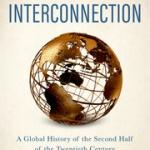A Breathless Race Through Recent History

The Age of Interconnection
A Global History of the Second Half of the Twentieth Century
Jonathan Sperber
ISBN: 9780190918958
It takes chutzpah to write a synoptic history of the world in the second half of the 20th century, a period within living memory of the reading public. But it is a history Jonathan Sperber handles with brio, summoning evidence from personal anecdotes and high theory, vignettes and statistics. In its range of themes and reconstructions, The Age of Interconnection invites favourable comparison with that other survey of the 20th century, Eric Hobsbawm’s The Age of Extremes. Yet it is quite unlike it. Where the Marxist historian offered a sweeping narrative arc illustrating the relentless advance of capitalism, Sperber dispenses with a unifying theme altogether. It’s a sign of the times: we’ve lost faith in grand narratives, more’s the pity. His framing sheds little light on his period. As every historian knows, all ages are ages of interconnection.
But what he loses in explanatory depth, he gains in intellectual breadth. Reading the book is a bit like watching a pentathlon. In lieu of fencing, riding, swimming, shooting and running, we have sections on the environment, economy, politics, society and cultural and intellectual life. It appears Sperber has taken Proust’s dictum to heart: “to write on everything to the point of exhaustion”. The exhaustiveness verges on redundancy at times, as in his tortuous excursions on staphylococcus and streptococcus infections, and rocket velocity. Class in the 20th century “took the form of a hierarchy”, he explains, as if to a Martian.
Nothing screamed mid-century ambition like five-year plans. There’s something touching about the confidence of the Soviets’ state planning committee, whose annual inventories of necessary commodities ran to 70 volumes and 12,000 pages. Not so China’s Second Five-Year Plan, the famous Great Leap Forward, which redirected farm labour to backyard furnaces to augment steel output, destroying crop yields and also some 30 million lives in the process.
Nature had its revenge, of course. The decimation of insects’ avian predators called into question the wisdom of spraying the midwest with DDT. Drug-resistant superbugs emerged. TB and malaria returned. Aids appeared on the scene. The blase response did little to help. “Aids is primarily a disease of homosexuals and there is no homosexual in Botswana,” an official declared. One of the statements must have been wrong, because by 2000, one in four adults there was HIV positive.
Five years after the release of David Bowie’s Life on Mars?, a 1976 Viking expedition to the planet answered his question. Nuclear missiles remained in their silos, but cigarettes accounted for the death of one in five men in the second half of the century. The oil shock revealed the dark sides of both communism and capitalism. Struggling to pay off dollar-denominated debts, the GDR had a Stasi agent sell art and literary manuscripts to western collectors for hard currency. Romania went further, “selling” Jews to western governments for $25,000 per person. Labour, king in the middle of the century – saving Juan Perón, then Argentina’s vice president, from a military coup in 1945; overthrowing Edward Heath in 1974 – lost to capital, which regained the upper hand after a string of strikes were put down in the early 80s, from Girangaon to Orgreave.
Pratinav Anil is a lecturer in history at St Edmund Hall, University of Oxford and author of Another India (Hurst).
